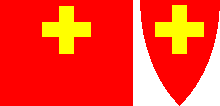Please note that during the Napoleonic era the eagle-topped staff alone usually acted as a regimental standard whilst on campaign, with the colour itself being retained at a regimental depot.
- Emblem, Military or Governmental
- A design of heraldic or other symbols which is not a set of armorial bearings/coat of arms or a badge as defined herein, but which is used to denote a particular branch or division of the military, or a specific department within a government structure but see badge 3) (also coat of arms, emblem 2), emblem, state and national', 'charge' and logo).
- Emblem, State or National
- A design of heraldic or other symbols which is not a set of armorial bearings/coat of arms or a badge as defined herein, but which is used to fulfil the function of a coat of arms in a national context. National emblems often epitomise the individuality and/or spirit of the state, and can be placed on a flag to distinguish it from others, which may be similar as, for example, those on the civil ensign of Italy and national flag of Mexico (see also badge, coat of arms, emblem 2) 'emblem, military and departmental', and 'charge').
Please note however, that the emblems of some countries such as those of Mexico (as shown above), or of Italy whilst conforming to the definition as detailed herein are officially described as coats of arms.
Please note however, that enhanced has a slightly different meaning when applied to the vexillological terms enhanced bend and enhanced bend sinister given below.
- Civil Ensign
- A flag flown by civilian owned vessels and craft to denote nationality a merchant ensign or merchant flag.
- Customs ensign
- See customs flag (also government ensign below).
- Government (or State) Ensign
- A flag flown to denote nationality by those government vessels that are not warships, sometimes defaced by badges to denote various departments but see archivexillum).
From left: Government Ensign of Singapore (fotw); Royal Maritime Auxiliary, UK (Graham Bartram)Please note however, that the defaced Blue Ensigns of British Dependent Territories act as both an official flag on land, and as a Government Ensign when flown by a Government owned vessel at sea.
- Naval Ensign
- A flag flown by the naval vessels of a particular country to denote nationality.
- Reserve Ensign
- A flag, different from the normal civil ensign, which is flown to denote nationality by merchant vessels commanded by an officer of that countrys naval reserve, and usually requiring a special Warrant (see also civil ensign above).
- War Ensign
- See naval ensign above (and also war flag).
- Yacht (or Leisure) Ensign
- A flag, different from the normal civil ensign, which is flown by leisure craft to denote nationality, usually requiring a special Warrant and often defaced by an appropriate club emblem (see also civil ensign above).
Please note that the provenance of this term is uncertain, however, a possible derivation from insignia-banner (as opposed to armorial banner) cannot be ignored.

![[east-west diagonal]](../images/v/vxt-d125.gif)
![[government and military emblem]](../images/v/vxt-d127.gif)
![[state or national emblem]](../images/v/vxt-d129.gif)
![[engrailed example]](../images/v/vxt-d131.gif)

![[enhanced bend example]](../images/v/vxt-d133.gif)
![[enhanced bend sinister example]](../images/v/vxt-d135.gif)
![[civil ensign example]](../images/v/vxt-d137.gif)
![[government (state) ensign example]](../images/v/vxt-d139.gif)
![[naval ensign example]](../images/v/vxt-d141.gif)
![[naval ensign example]](../images/v/vxt-d143.gif)
![[yacht ensign example]](../images/v/vxt-d145.gif)